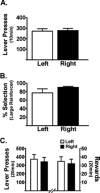Mirtazapine and ketanserin alter preference for gambling-like schedules of reinforcement in rats
- PMID: 28412411
- PMCID: PMC5656013
- DOI: 10.1016/j.pnpbp.2017.03.027
Mirtazapine and ketanserin alter preference for gambling-like schedules of reinforcement in rats
Abstract
Drug and behavioral addictions have overlapping features, e.g., both manifest preference for larger, albeit costlier, reinforcement options in cost/benefit decision-making tasks. Our prior work revealed that the mixed-function serotonergic compound, mirtazapine, attenuates behaviors by rats motivated by abused drugs. To extend this work to behavioral addictions, here we determined if mirtazapine and/or ketanserin, another mixed-function serotonin-acting compound, can alter decision-making in rats that is independent of drug (or food)-motivated reward. Accordingly, we developed a novel variable-ratio task in rats wherein intracranial self-stimulation was used as the positive reinforcer. Using lever pressing for various levels of brain stimulation, the operant task provided choices between a small brain stimulation current delivered on a fixed-ratio schedule (i.e., a predictable reward) and a large brain stimulation delivered following an unpredictable number of responses (i.e., a variable-ratio schedule). This task allowed for demonstration of individualized preference and detection of shifts in motivational influences during a pharmacological treatment. Once baseline preference was established, we determined that pretreatment with mirtazapine or ketanserin significantly decreased preference for the large reinforcer presented after gambling-like schedules of reinforcement. When the rats were tested the next day without drug, preference for the unpredictable large reinforcer option was restored. These data demonstrate that mirtazapine and ketanserin can reduce preference for larger, costlier reinforcement options, and illustrate the potential for these drugs to alter behavior.
Keywords: Cost/benefit decision-making; Gambling; Intracranial self-stimulation; Serotonin; Variable-ratio.
Copyright © 2017 Elsevier Inc. All rights reserved.
Conflict of interest statement
The authors have no financial conflict of interest with respect to the content of this manuscript.
Figures




Similar articles
-
Functional disconnection of the orbitofrontal cortex and basolateral amygdala impairs acquisition of a rat gambling task and disrupts animals' ability to alter decision-making behavior after reinforcer devaluation.J Neurosci. 2013 Apr 10;33(15):6434-43. doi: 10.1523/JNEUROSCI.3971-12.2013. J Neurosci. 2013. PMID: 23575841 Free PMC article.
-
Anticonvulsant medications attenuate amphetamine-induced deficits in behavioral inhibition but not decision making under risk on a rat gambling task.Behav Brain Res. 2016 Nov 1;314:143-51. doi: 10.1016/j.bbr.2016.08.016. Epub 2016 Aug 8. Behav Brain Res. 2016. PMID: 27515288
-
Reversal of long-term methamphetamine sensitization by combination of pergolide with ondansetron or ketanserin, but not mirtazapine.Behav Brain Res. 2011 Sep 30;223(1):227-32. doi: 10.1016/j.bbr.2011.04.045. Epub 2011 May 7. Behav Brain Res. 2011. PMID: 21571009 Free PMC article.
-
Examining the neurochemical underpinnings of animal models of risky choice: Methodological and analytic considerations.Exp Clin Psychopharmacol. 2019 Apr;27(2):178-201. doi: 10.1037/pha0000239. Epub 2018 Dec 20. Exp Clin Psychopharmacol. 2019. PMID: 30570275 Free PMC article. Review.
-
Suboptimal choice by pigeons: an analog of human gambling behavior.Behav Processes. 2014 Mar;103:156-64. doi: 10.1016/j.beproc.2013.11.004. Epub 2013 Nov 27. Behav Processes. 2014. PMID: 24291801 Free PMC article. Review.
Cited by
-
Risk-Based Decision Making: A Systematic Scoping Review of Animal Models and a Pilot Study on the Effects of Sleep Deprivation in Rats.Clocks Sleep. 2021 Jan 20;3(1):31-52. doi: 10.3390/clockssleep3010003. Clocks Sleep. 2021. PMID: 33498259 Free PMC article.
-
Methylation Patterns of the HTR2A Associate With Relapse-Related Behaviors in Cocaine-Dependent Participants.Front Psychiatry. 2020 Jun 10;11:532. doi: 10.3389/fpsyt.2020.00532. eCollection 2020. Front Psychiatry. 2020. PMID: 32587535 Free PMC article.
References
-
- Bechara A, Dolan S, Denburg N, Hindes A, Anderson SW, Nathan PE. Decision-making deficits, linked to a dysfunctional ventromedial prefrontal cortex, revealed in alcohol and stimulant abusers. Neuropsychologia. 2001;39:376–389. - PubMed
-
- Blanco C, Petkova E, Ibanez A, Saiz-Ruiz J. A pilot placebo-controlled study of fluvoxamine for pathological gambling. Ann Clin Psychiatry. 2002;14:9–15. - PubMed
MeSH terms
Substances
Grants and funding
LinkOut - more resources
Full Text Sources
Other Literature Sources
Medical

